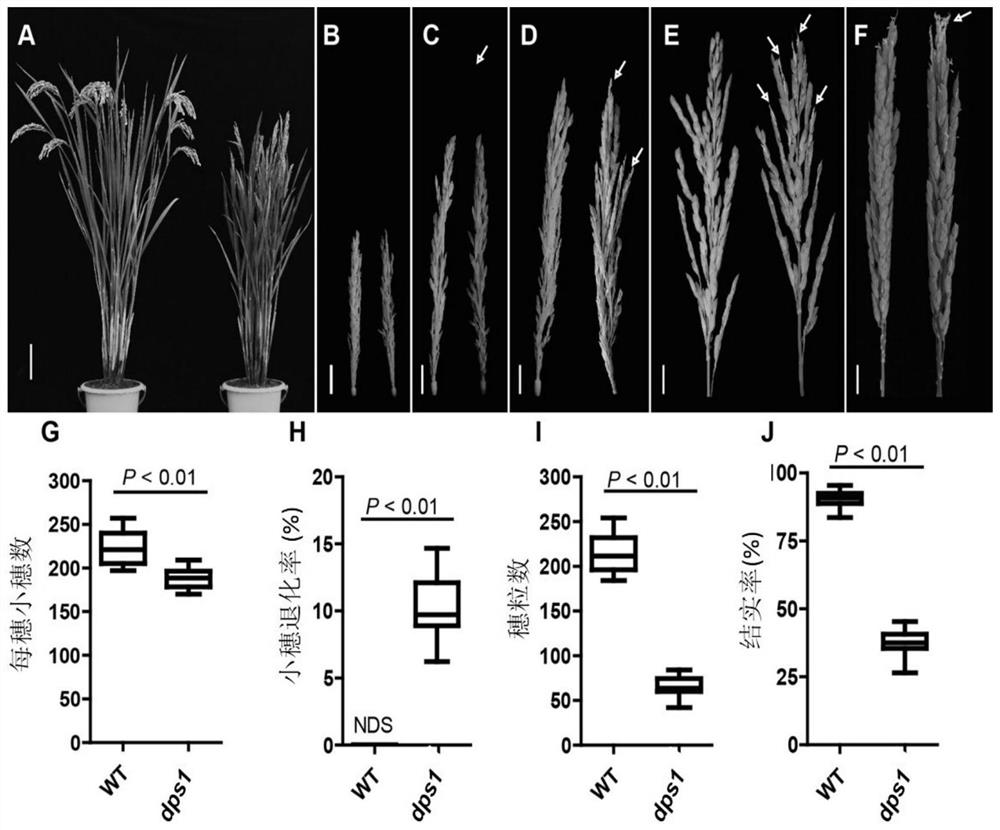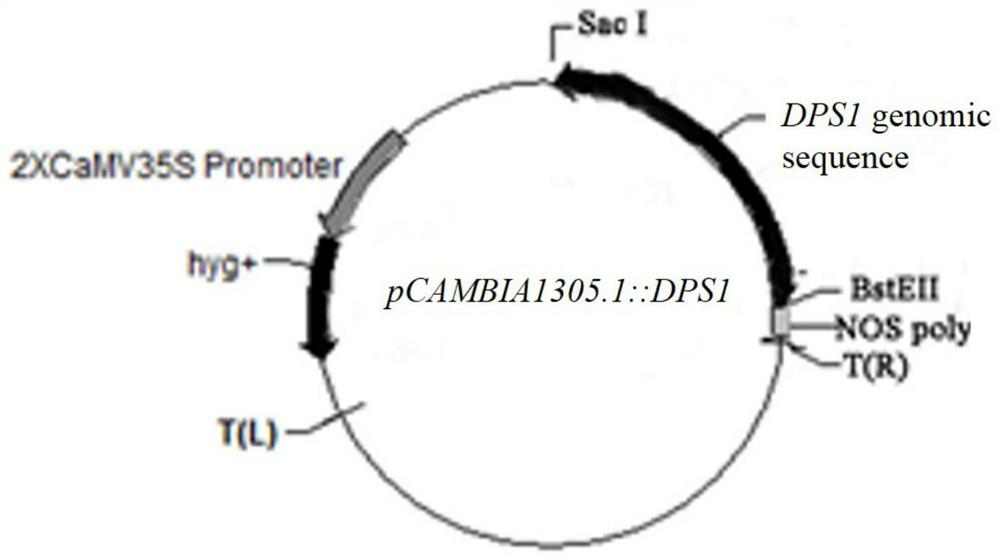Application of rice dps1 gene and its encoded protein
A technology of DPS1 and rice, which is applied in the field of genetic engineering, can solve the problems of unexplored, reduce spikelet degeneration rate, and unresolved molecular mechanism of top spikelet degeneration, so as to achieve the effect of increasing rice yield and reducing incidence
- Summary
- Abstract
- Description
- Claims
- Application Information
AI Technical Summary
Problems solved by technology
Method used
Image
Examples
Embodiment 1
[0040] The acquisition and phenotype analysis of embodiment 1 mutant
[0041] The japonica rice Shengdao 16 was mutagenized with ethyl methanesulfonate (EMS), and a panicle tip degenerated mutant dps1 (degenerated panicle and spikelet 1, dps1) was screened ( figure 1 A). In the early stage of growth and development, the vegetative growth and reproductive growth of the dps1 mutant were normal, and there was no obvious difference compared with the wild type, and continued until the young panicle developed to about 10 cm ( figure 1 the B, figure 1 C); when the young ear reached about 12cm, the spikelet at the top of the mutant ear was pale white, stagnated, and obvious degeneration occurred ( figure 1 the D, figure 1 E); with the further development of rice spikelets, the degenerated spikelets at the top continued to increase, and this degeneration phenomenon became more obvious when the spikelets reached their final length before anthesis, manifested as shriveled necrosis ( ...
Embodiment 2
[0044] The acquisition of embodiment 2 rice DPS1 gene
[0045] Crossing the dps1 mutant with the phenotypically normal indica rice variety Huanghuazhan, F 1 Behaved normally, in F 2 In the generation segregation population, the segregation ratio of normal individual plants and mutant individual plants was 3:1, which indicated that the mutant traits were controlled by a pair of recessive genes. with F 2 The 30 mutants were used as materials, and the candidate gene was located between the Indel markers M1 and M7 of the fifth chromosome by using 170 Indel markers evenly distributed on the 12 chromosomes of rice. In order to fine-map the gene, the F 2 The population was expanded to 472 mutant individuals, and the candidate genes were located within the 28.85kb range between INDEL markers M3 and M5 ( figure 2 A). This interval contains 6 open reading frames, among which the gene sequence numbered Os05g0395300, its gene function is related to the phenotype, so the full-length ...
Embodiment 3
[0048] Example 3 pCAMBIA1305.1:: DPS1 vector transformation of rice dps1 mutant
[0049] In order to carry out the functional complementation experiment, the DPS1 gene functional complementation vector driven by its own promoter and the overexpression vector driven by the rice ACTIN1 promoter were respectively constructed. The DPS1 gene functional complementation vector is driven by the gene's own promoter. The 2011 bp before the translation initiation site ATG is selected as the gene promoter, and the genomic DNA is used as the template for PCR amplification. The amplification primers used are DPS1-gDNA shown in Table 2. -C. The 5' end introduces an EcoRI site and the 3' end introduces a SpeI site, and the PCR product is 9685bp long (sequence shown in SEQ ID NO.1), and finally its own promoter together with the entire genomic DNA (shown in SEQ ID NO.1 sequence) were cloned into the pCAMBIA1305.1 vector together to form a complementary vector driven by its own promoter ( im...
PUM
 Login to View More
Login to View More Abstract
Description
Claims
Application Information
 Login to View More
Login to View More - R&D
- Intellectual Property
- Life Sciences
- Materials
- Tech Scout
- Unparalleled Data Quality
- Higher Quality Content
- 60% Fewer Hallucinations
Browse by: Latest US Patents, China's latest patents, Technical Efficacy Thesaurus, Application Domain, Technology Topic, Popular Technical Reports.
© 2025 PatSnap. All rights reserved.Legal|Privacy policy|Modern Slavery Act Transparency Statement|Sitemap|About US| Contact US: help@patsnap.com



